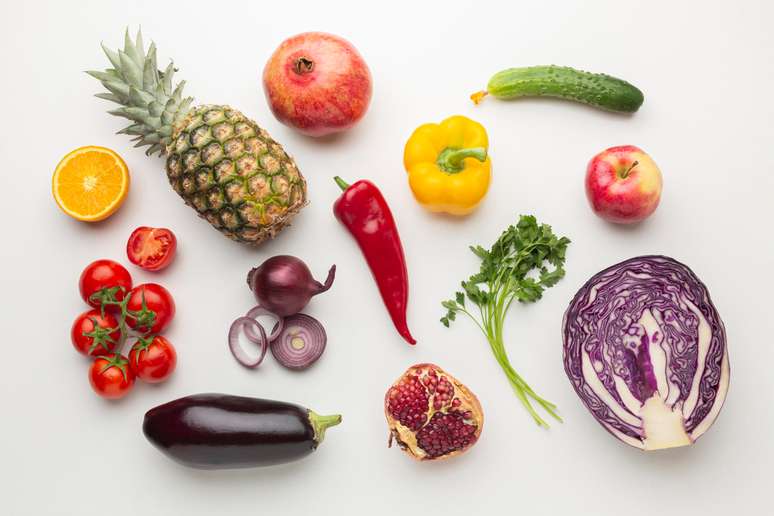Only 24.1% of Brazilians eat the amount of fruit and vegetables recommended by the World Health Organization (WHO)
Only 24.1% of Brazilians eat the amount of fruit and vegetables recommended by the World Health Organization (WHO), i.e. 400 g of vegetables per day; this value can be achieved by including approximately 5 portions of vegetables in the daily menu. If you’re part of this group, we have great news: we consulted nutritionists to understand what “tricks” they recommend to their patients to get them to eat more fruits and vegetables.
You know that fruit and vegetables are good for you. So why is it so difficult to get the recommended number of daily servings? Typical responses include: you’re too busy, tired, or stressed. Or maybe it’s a challenge because you’re on a budget or you’re just not a fan of cooking.
But why this pressure for more plants?
Well, science shows that incorporating a variety of fruits and vegetables into your diet is a great way to control weight, improve heart health, and prevent chronic disease. These foods contain a wide variety of nutrients that your body needs to strengthen your immune system, fight infections, and function at its best.
In other words, it is worth making the efforts mentioned below to reap all the benefits.

1. Sign up for a delivery cart
It’s essentially like a product subscription box. Members pay a fixed amount up front to receive a weekly box of produce (usually organic) delivered straight to their door. As well as making shopping easier, the variety of fruit and vegetables (seasonal produce is sent) will let you try new foods, which you may find you love.
2. Choose what you love
Stop trying to force yourself (and your loved ones) to eat fruits or vegetables they don’t like. The ideal is to abandon the food mentality that tells you to eat as many fruits and vegetables as possible, even if you don’t like the taste.
This mentality typically backfires and leaves people resentful and avoiding fruits and vegetables. Then, after you figure out what you like, focus on those options.
3. Create a rainbow
Visually appealing foods are much more appetizing than bland and boring dishes. Therefore, nutritionists suggest that the most demanding palates prepare a plate of fruit and vegetables organized according to the colors of the rainbow.
Roast a variety of vegetables on a large baking sheet, keeping them in their colored line, or chop fresh produce and arrange it on a large cutting board before offering it to people who help themselves.
4. Modify the delivery
It all depends on how you serve your favorite fruits and vegetables. Cutting fruit and vegetables and putting them on skewers makes everything more fun and appetizing.
5. Watch your seasonings
The secret weapon to enhance the flavor of your dishes could be right in front of you. For example, coating vegetables with mustard before frying them will add a slightly spicy flavor and help the seasonings adhere to what you’re cooking.
6. Add vegetables to your favorite dishes
Be creative in how you incorporate vegetables into your diet. For example, you can incorporate vitamin D-rich mushrooms into your favorite meat dishes. Simply blend in a blender or food processor until ground but not crushed, mix with the meat, and cook as normal. Works fabulously with meatballs, gravy, meatloaf, tacos and more.
7. Blend and freeze
If you eat the same vegetables every week, try this trick: Go to the store and choose 10 to 12 different plant foods and throw them in a high-speed blender. Freeze in ice cube molds and add 2 cubes to each prepared smoothie. Tip: Mix and freeze each fruit or vegetable separately, as some flavor combinations may not go well together.
8. Change the preparation
Are you a fan of carrots? Eating raw carrots can get old fast, but try roasting them with a little olive oil and salt or use a mandolin to create a carrot pasta salad.
9. Set goals
If you’re a super organized and goal-oriented person, scheduling the fruits and vegetables you eat each week might be a good solution for you. Select 8 to 12 vegetables and, on a monthly calendar, schedule 2 to 3 varieties per week.
10. Start early
Fruits and vegetables aren’t just for lunch and dinner. Try them for breakfast! You can incorporate fruit into smoothies and yogurt or use it as a topping on waffles and breakfast cereals. If you’re an egg fan, add greens like spinach, kale, peppers and onions to egg dishes or toss them with salsa or microgreens.
11. Make a fry
If in doubt, put some vegetables in the pan. Frying vegetables is a fun and easy way to enjoy a variety of vegetables and is a versatile dish that allows us to change up flavors and textures.
12. Question yourself
Make an active effort to include fruits and/or vegetables in every meal (or snack). Simplicity is the key. Before you finish preparing a meal, ask yourself, “Can I put fruit and/or vegetables here?” And then incorporate one or two portions.
13. Turn veggies into chips
Who doesn’t love a good french fry? Make a more nutritious version by turning vegetables into chips. Cut carrots or courgettes into sticks, toss them in extra virgin olive oil or avocado oil, and add your favorite seasonings before placing them in the fryer.
14. Try old vegetables in new ways
Do you “hate” broccoli because your parents made it over-steamed, mushy, and brownish when you were a child? Apparently this is common. We often avoid vegetables because of the way they were prepared at home when we were growing up. But before you discard a vegetable, try cooking and preparing it in different ways.
Source: Terra
Ben Stock is a lifestyle journalist and author at Gossipify. He writes about topics such as health, wellness, travel, food and home decor. He provides practical advice and inspiration to improve well-being, keeps readers up to date with latest lifestyle news and trends, known for his engaging writing style, in-depth analysis and unique perspectives.







